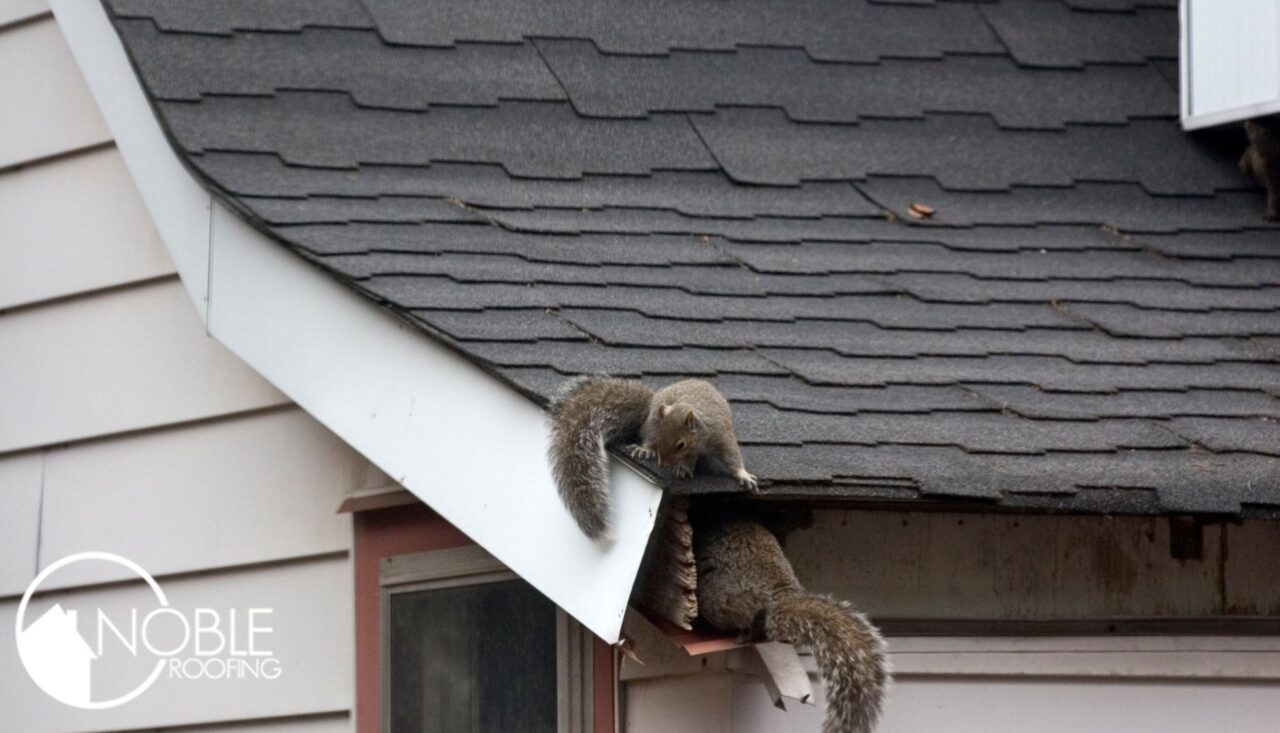Can Squirrels Live in Your Attic? Yes—And Here’s How to Stop Them
Your attic may be cozy, dry, and quiet: exactly the kind of place a wild animal would love to call home. Squirrels, raccoons, birds, and other critters are always on the lookout for safe shelter, and your attic is prime real estate. That’s why safeguarding your attic entry points and inspecting vulnerable areas is essential to prevent unwelcome guests from settling in.
While they are cute and cuddly, having wild animals take up residence in your roof can spell trouble for your home in the long run. If you notice that animals have breached your home, call Noble Roofing (after you call pest control) to get a roof inspection so we can identify if your roof is offering points of entry to these critters.
Why You Need to Safeguard Your Attic Entry Points
Even small gaps in your roofline, soffits, vents, or flashing can become an open door to wild animals. Squirrels can squeeze through holes as small as 2 inches wide, raccoons can tear through weakened wood or vents, and bats only need a gap the size of a quarter.
Key areas to check include:
-
Roof vents and fans
-
Chimneys and attic fans
-
Eaves and soffits
-
Roof flashing
-
Damaged shingles
-
Fascia boards and gables
Regular inspections—especially after storms or heavy winds—can catch issues before they become costly animal invasions.
What Kind of Damage Can Animals Cause in Your Attic?
Animal intruders aren’t just a nuisance—they can do serious and expensive damage.
-
Chewed Wires – Squirrels and rodents are notorious for gnawing on electrical wires, creating a fire hazard.
-
Soiled Insulation – Urine and feces can saturate insulation, leading to foul odors, mold, and poor air quality.
-
Structural Damage – Raccoons can break boards and tear insulation or ductwork apart during nest-building.
-
Pest Infestations – Once animals are inside, they can bring fleas, mites, and parasites with them.
Left unchecked, the damage can total thousands of dollars and affect both your home’s safety and its resale value.
What Kinds of Animals Break Into Attics?
Many types of wildlife may try to move into your attic, especially during colder months or nesting season. Common attic invaders include:
-
Squirrels – Agile climbers who chew through wood and fascia
-
Raccoons – Strong and clever, they can pry open vents and tear through shingles
-
Birds – Often enter through broken vents or chimney flues
-
Bats – Silent intruders that often go undetected until you see droppings
-
Mice and Rats – Enter through even the tiniest cracks and reproduce quickly
Knowing what to look for can help you recognize signs of an infestation early.
How Do Animals Get Into Attics?
Most animals enter attics by exploiting structural weaknesses or gaps in the roof. They may:
-
Chew or claw through weak wood
-
Enter through uncovered or damaged vents
-
Slip through cracks in flashing or roof junctions
-
Climb trees and access your roof via overhanging branches
-
Use chimneys or broken attic fans as entry points
It only takes one small opening for an entire family of animals to move in.
How Regular Roof Inspections Can Prevent Animal Problems
One of the easiest ways to stop squirrels and other pests from moving into your attic is by staying proactive with roof care. Small issues—like loose flashing, missing shingles, or cracked vents—can quickly become entry points for animals looking for shelter.
Here’s how regular inspections help:
-
Identify and seal small openings before animals find them
-
Catch water damage or rot that weakens structures animals can exploit
-
Ensure vent covers and attic fans are intact and properly screened
-
Spot nests or droppings early, before infestations grow
Scheduling routine inspections with a trusted roofing professional keeps your roof animal-proof and in top condition year-round.
How to Relocate Animal Families Humanely
If you suspect animals are living in your attic, avoid sealing the area right away—especially during spring and summer when babies may be present. Here’s how to handle it humanely:
-
Call a wildlife removal professional – They’ll assess the situation and safely remove the entire family.
-
Avoid traps or poison – These can be dangerous, inhumane, and may not solve the problem long-term.
-
Install one-way doors – These allow animals to exit but not re-enter, giving them time to relocate safely.
-
Inspect and seal – After the animals are gone, seal all potential entry points to prevent future infestations.
Humane relocation is the best way to respect local wildlife and protect your home at the same time.
Protect Your Attic Before It Becomes an Animal Hotel
Your attic should be a storage space—not a home for wild animals. Routine inspections, strong roof maintenance, and quick repairs to vulnerable areas are your best defense. If you suspect damage or a potential entry point, don’t wait.
Call Noble Roofing today for a professional attic and roof inspection—before the squirrels move in!


